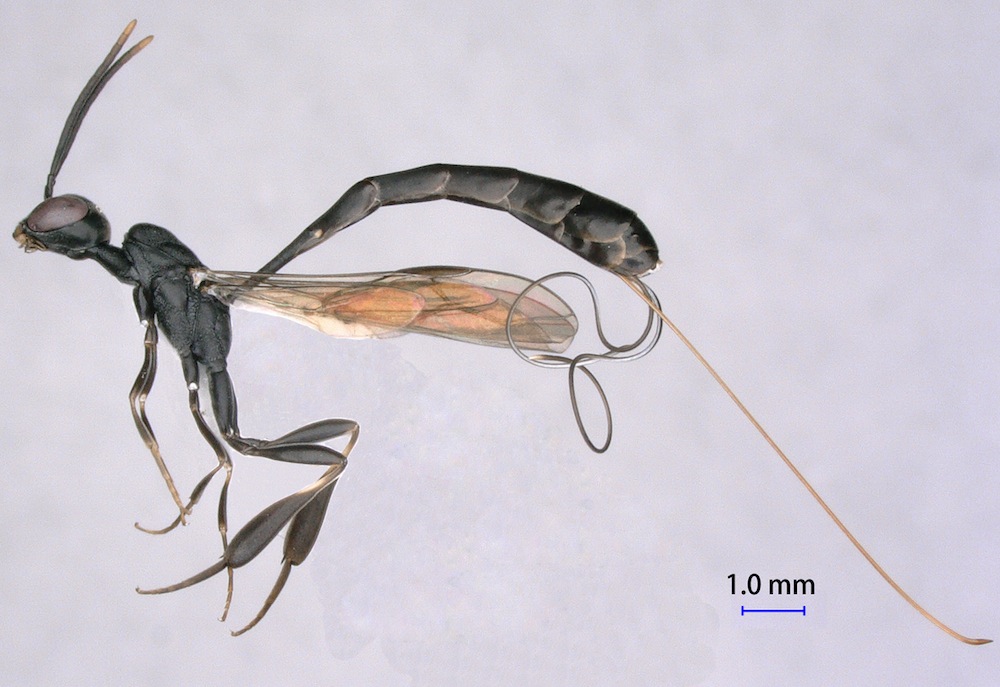Four New Wasp Species Identified in China

Four species of parasitoid wasps have been discovered in northwest China, a new study reports.
The new species belong to the genus Gasteruption. These wasps have slender bodies and inflated, club-shaped hind legs. They also have elongated necks, and keep their abdomens raised and hind legs dangling during their slow, quiet flights. Their heads have a satin-like sheen and long eyes that extend almost to their mouth, the researchers said.
The four new species — G. bicoloratum, G. huangshii, G. pannuceum and G. shengi — have a body covering that resembles black leather with grooves and stitches. The bugs range in size from 0.3 inches (8 millimeters) long to 0.5 inches (13 mm) long, and females are typically larger than males. [Googly Eyes: Photos of Striking Wasp Faces]
The newfound species are parasitoid wasps whose larvae are parasites that kill their hosts. Adults hover outside the nests of solitary bees. While females hover to find an opportunity to sneak their own eggs into solitary bee nests, males typically linger in search of these females. Using a long, tube-like organ, called an ovipositor, the female lays eggs inside bee nests. The emerging larvae feed on bee eggs and larvae, and the food reserves of the nest. The young wasps pupate in their hosts' nests and emerge as adults in spring.
The adult wasps can be locally abundant at times, particularly when they are feeding on pollen and nectar at flowers, said Jiang-Li Tan, an entomologist in the College of Life Sciences at Northwest University in China. But, "they are not encountered frequently and, in many regions of the world, are rarely collected," she said.
A total of 28 species of Gasteruption were known from China before the new finds. Tan's team discovered four new species in the mountainous region of China's Shaanxi and Ningxia provinces. Tan lives near the Qinling mountains in Shaanxi, and every weekend during spring and summer, she would drive there with her students to sample wasps.
"I am not surprised to find four new species," Tan told Live Science in an email. She added that there are likely more wasp species waiting to be found. But, it is not easy to identify a new species, Tan said. A combination of characteristics such as the shape of the head and legs, length of ovipositor, skin pattern, body color, and wing pattern and color, were used.
Sign up for the Live Science daily newsletter now
Get the world’s most fascinating discoveries delivered straight to your inbox.
G. bicoloratum was found at an elevation of around 3,600 feet (1,100 meters) above sea level. The species gets its name from its bicoloured hind legs, which are ivory and yellowish-brown. At 0.05 inches (1.2 mm) long, the ovipositor of females is very short, the scientists note in the paper. [No Creepy Crawlies Here: Gallery of the Cutest Bugs]
G. huangshii was named after Huang Shi Gong — believed to be a teacher of a Han Dynasty general — since the wasp was found near his statue. It was found at an elevation of 4,400 feet (1,350 m) above sea level. In females of this species, the ovipositor is very long, about 1.2 times the length of the body, the study finds.
G. pannuceum (from the Latin word "pannuceus," meaning "wrinkled") gets its name from the wrinkled sheath covering its midbody. And, G. shengi was named after its collector, Mao-Ling Sheng, in recognition of his work on parasitoid wasps of China. The largest of the four new species, G. shengi wasps are covered in dense, silvery hair, the researchers wrote in the study.
The findings were published online Aug. 23 in the journal ZooKeys.
Original article on Live Science.










